Related Research Articles

Archie Comic Publications, Inc., is an American comic book publisher headquartered in Pelham, New York. The company's many titles feature the fictional teenagers Archie Andrews, Jughead Jones, Betty Cooper, Veronica Lodge, Reggie Mantle, Sabrina Spellman, Josie and the Pussycats and Katy Keene. The company is also known for its long-running Sonic the Hedgehog comic series, which it published from 1992 until 2016.
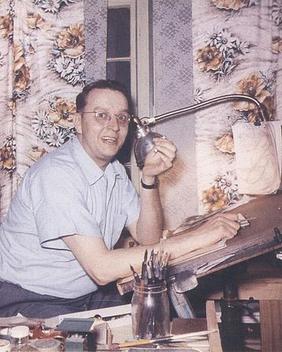
Jack Ralph Cole was an American cartoonist best known for birthing the comedic superhero Plastic Man, and his cartoons for Playboy magazine.
William Van Horn is an American Disney comics artist and writer, and has been since 1988. He draws mostly Donald Duck and Uncle Scrooge stories, and he has also written and/or illustrated stories based on the animated series DuckTales. Some of these stories featured Launchpad McQuack as the main character. William's son Noel Van Horn is also a Disney comics artist, focusing on Mickey Mouse stories.

An American comic book is a thin periodical originating in the United States, on average 32 pages, containing comics. While the form originated in 1933, American comic books first gained popularity after the 1938 publication of Action Comics, which included the debut of the superhero Superman. This was followed by a superhero boom that lasted until the end of World War II. After the war, while superheroes were marginalized, the comic book industry rapidly expanded and genres such as horror, crime, science fiction and romance became popular. The 1950s saw a gradual decline, due to a shift away from print media in the wake of television and the impact of the Comics Code Authority. The late 1950s and the 1960s saw a superhero revival and superheroes remained the dominant character archetype throughout the late 20th century into the 21st century.

Dark Circle Comics is an imprint of Archie Comics Publications, Inc. Under its previous name, Red Circle Comics, it published non-humor characters, particularly superheroes in the 1970s and 1980s.

The Shield is the name of several superheroes created by MLJ. Appearing months before Captain America, the Shield has the distinction of being the first superhero with a costume based upon United States patriotic iconography. The character appeared in Pep Comics from issue #1 to #65.
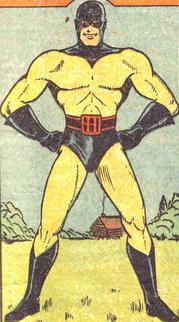
The Black Hood is the name of several fictional characters created by MLJ Comics during the period known as the "Golden Age of Comic Books". The Black Hood first appeared in Top-Notch Comics #9, October 1940 and became one of MLJ's most popular characters. He has been in four self-titled series as well as in his own radio show, Black Hood (1943–1944). In recent decades, the Black Hood has been sporadically licensed and published by DC Comics. However, the character reappeared under Archie Comics' Dark Circle Comics line in 2015.

Pep Comics is an American comic book anthology series published by the Archie Comics predecessor MLJ Magazines Inc. during the 1930s and 1940s period known as the Golden Age of Comic Books. The title continued under the Archie Comics imprint for a total of 411 issues until March 1987.

The Fox is the name of two superheroes that appear in periodicals published by MLJ Comics and later Dark Circle Comics.

Captain Flag is a superhero created by MLJ Comics' writer Joe Blair and artist Lin Streeter. He first appeared in September 1941, in issue #16 of Blue Ribbon Comics. He continued until the last issue, Blue Ribbon Comics #22.
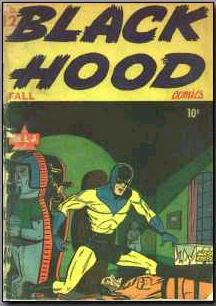
Black Hood Comics was the name of an American anthology comic book series published by MLJ Magazines Inc., more commonly known as MLJ Comics, for eleven issues between Winter 1943 and Summer 1946. The series featured MLJs costumed hero Black Hood, and "Boy Buddies", featuring Shield's partner 'Dusty the Boy Detective' and Wizard's side-kick 'Roy the Superboy', together with humor strips.

The Masked Marvel is a fictional superhero originally published by Centaur Publications. He debuted in July 1939, on the pages of Keen Detective Funnies #7. The character continued to appear as the feature in Keen Detective Funnies until the 24th issue, as well as in his own title, which lasted three issues.
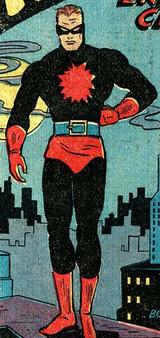
Firefly is a superhero created by Harry Shorten and Bob Wood for MLJ Comics in 1940. He first appeared in Top-Notch Comics #8. Artist Warren King and writer Joe Blair loaned their talents to many of the Firefly's installments.
The Wizard is a superhero created by Will Harr and Edd Ashe Jr. for MLJ Comics, which later became Archie Comics. He first appeared in Top-Notch Comics #1 in December 1939, and he was one of the headliners of that title until its cancellation in 1944. He was one of the earliest superhero characters to appear after the debut of Superman in 1938.
Novelty Press was an American Golden Age comic-book publisher that operated from 1940 to 1949. It was the comic book imprint of Curtis Publishing Company, publisher of The Saturday Evening Post. Among Novelty's best-known and longest-running titles were the companion titles Blue Bolt and Target Comics.
Harry Frank Sahle was an American comic book artist who drew for such publishers as Archie Comics—helping create the defined look of Archie Comics' breakout character, Archie Andrews—Quality Comics and the Marvel Comics precursor company Timely Comics during the 1930s-1940s period historians and fans call the Golden Age of Comic Books.

Jackpot Comics was the name of an American anthology comic book magazine series published by MLJ Magazines Inc., more commonly known as MLJ Comics, for nine issues between Spring 1941 and Spring 1943. It featured new stories of a number of characters previously seen in other MLJ publications.

Hangman Comics was the name of an American anthology comic book series published by MLJ Magazines Inc., more commonly known as MLJ Comics, for seven issues between Spring 1942 and Fall 1943. It featured MLJs costumed vigilante The Hangman, and "Boy Buddies", featuring Shield's partner 'Dusty the Boy Detective' and Wizard's side-kick 'Roy the Superboy', throughout the series.
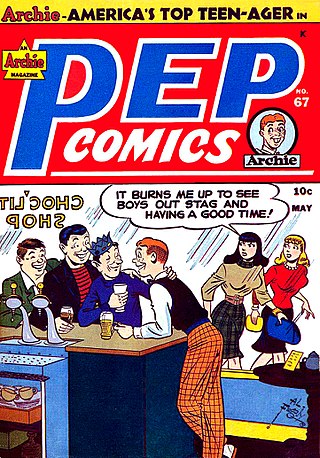
Al Fagaly was a Golden Age American cartoonist and creator of Archie Comics' Super Duck and the syndicated gag cartoon There Oughta Be a Law!.
Harry Shorten (1914–1991) was an American writer, editor, and book publisher best known for the syndicated gag cartoon There Oughta Be a Law!, as well as his work with Archie Comics, and his long association with Archie's publishers Louis Silberkleit and John L. Goldwater. From the late 1950s until his 1982 retirement, Shorten was a book publisher, overseeing such companies as Leisure Books, Midwood Books, Midwood-Tower Publications, Belmont Tower, and Roband Publications.
References
- ↑ Castiglia, Paul; Cooke, Jon B. (2016). "Last... But Hardly Least... Super Duck!". The MLJ Companion. TwoMorrows Publishing. pp. 110–111. ISBN 9781605490670 . Retrieved 14 April 2020.
- ↑ Becattini, Alberto (2019). "Super-Animals". American Funny Animal Comics in the 20th Century: Volume Two. Theme Park Press. ISBN 978-1683902218.
- ↑ Markstein, Don. "Super Duck, the Cockeyed Wonder". Don Markstein's Toonopedia. Retrieved 14 April 2020.
- ↑ Rovin, Jeff (1991). The Illustrated Encyclopedia of Cartoon Animals. Prentice Hall Press. pp. 252–253. ISBN 0-13-275561-0 . Retrieved 8 April 2020.
- ↑ Mitchell, Kurt; Thomas, Roy (2019). American Comic Book Chronicles: 1940-1944. TwoMorrows Publishing. p. 191. ISBN 978-1605490892.
- ↑ "A superhero that'll quack you up! SUPER DUCK #1 launches March 25". 2 March 2020.
- ↑ Nevins, Jess (2013). Encyclopedia of Golden Age Superheroes. High Rock Press. p. 262. ISBN 978-1-61318-023-5.
- ↑ Reprinted in Laugh Comics Digest #13 (Archie Comics, Nov. 1977).
- ↑ Crumb, R. "Freak Show," Mystic Funnies #3 (Fantagraphics, 2002).